AUCTORES
Globalize your Research
Research | DOI: https://doi.org/10.31579/2693-4779/105
1 Laboratory Service, National Hospital Center of Nouakchott, Mauritania.
2 Faculty of Medicine of Nouakchott, Mauritania.
3 Internal Medicine Service, National Hospital Center of Nouakchott, Mauritania.
*Corresponding Author: Mohamed Lemine Ould Salem, Laboratory Service, National Hospital Center of Nouakchott, Mauritania, Microbiology Laboratory, Nouakchott Faculty of Medicine.
Citation: Mohamed Lemine Ould Salem, Fatimettou Abdellahi, Mohamed Ahmed MM Sidiya, Sidi Mohamed Ghaber, Sidi El Wafi Ould Baba. (2022) Current state of resistance to antibiotics inenterobacterialisolated at the National Hospital Center of Nouakchott-Mauritania. Clinical Research and Clinical Trials. 6(3); DOI:10.31579/2693-4779/105
Copyright: © 2022 Mohamed Lemine Ould Salem. This is an open access article distributed under the Creative Commons Attribution License, which permits unrestricted use, distribution, and reproduction in any medium, provided the original work is properly cited.
Received: 15 June 2022 | Accepted: 28 June 2022 | Published: 22 July 2022
Keywords: enterobacteriaceae; e. coli; antibiogram; nouakchott; mauritania
Enterobacteriaceae are Gram-negative bacteria, facultative aero-anaerobes found everywhere. They include a very large number of genera and species. Their abundance in the intestine, their mobility, the rapidity of their multiplication, the frequent acquisition of mechanisms of resistance to antibiotics.
Objective : The objective of this study was to investigate the antibiotic susceptibility of Enterobacteriaceae strains isolated from various infectious sites in outpatients and hospitalized patients.
Material and method: This is a prospective study carried out in the central laboratory of the Nouakchott Hospital Center and involving 300 strains of enterobacteriaceae isolated from various samples taken from different departments or external consultations. The study was conducted from November 1, 2020 to July 30, 2021
Results : In our study E. coli represents (66.6%), followed by K. pneumoniae (27%), E. cloacae (2.3%). The study of the resistance of these strains to antibiotics revealed resistance rate: Amoxicicillin (93%), Amoxicillin-clavulanic acid (77.6%), Gentamicin (16%) and (9.4%) Fosfomycin.
Conclusion : The significant increase in the frequency of enterobacteriaceae has become worrying in both hospital and community settings. However, implementation requires collective awareness through in-depth training of healthcare teams. Currently, the reference treatment for infections due to multiresistant enterobacteria is essentially based on the use of carbapenems. It is nevertheless fundamental to obey a rational prescription of these antibiotics to limit the emergence of carbapenemase-producing strains. Controlling the spread of enterobacteriaceae requires strict compliance with simple hospital hygiene measures.
Enterobacteriaceae are Gram-negative bacteria, aero-facultative anaerobes found everywhere in soil, in water and especially in the intestine of humans and animals. They include a very large number of genera and species. Their abundance in the intestine, their mobility, the speed of their multiplication, the frequent acquisition of antibiotic resistance mechanisms explain why they are the bacteria most involved in human infectious pathology, especially in the hospital environment [1]. The majority of urinary tract infections have a bacterial origin, and the most frequently encountered pathogens are enterobacteriaceae.[2].Escherichia coli is the most incriminated germ; it is responsible in 85% of cases, Klebsiella pneumoniae comes in second position with 10% of cases, Proteus mirabilis comes in third position with 4% of cases, other Gram-negative bacilli (Pseudomonas aeruginosa) or Gram-positive Cocci ( Staphylococcus saprophyticus, Staphylococcus aureus, Enterococcus sp) may less often be the cause [3]. Literature data show that Escherichia coli is the predominant bacterium in UTI [4]. About 150 million cases of urinary tract infections per year in the world, they constitute as such a public health concern [5]. Enterobacteriaceae are implicated in pneumonia, mainly in a nosocomial context of ventilator-acquired pneumonia and aspiration pneumonia [6]. Escherichia coliwas the leading cause of bacteriemia in France, ahead of Staphylococcus aureus [7] The Global Antimicrobial Resistance Surveillance System (known as GLASS) reveals that antibiotic resistance is a widespread problem affecting 500,000 people with suspected bacterial infections in 22 countries. It is also reported that the most frequently reported resistant bacteria include Escherichia coli; Klebsiella pneumoniae; Salmonella spp [8]. In Europe, the European Center for Disease Control (ECDC) has estimated the number of deaths resulting from antibiotic resistance at 25,000 per year [9]. Around 700,000 people worldwide die each year from drug-resistant infections and, if left unchecked, these infections are estimated to cause 10 million people to die annually by 2050. The situation is alarming in countries with limited resources where infectious diseases, poverty and malnutrition are endemic. The emergence of antibiotic resistance is a complex process often involving host, pathogen and environmental factors. In recent years, an increase in the incidence of resistance to antibiotics of germs responsible for urinary tract infections has been observed. The outbreak of Extended Spectrum Beta-lactamase (ESBL)-secreting Enterobacteriaceae is increasingly prevalent [10]. In West Africa, as throughout the world, antibiotic resistance mainly concerns bacteria producing ESBL [11]. The causes of the emergence and dissemination of this resistance are multiple, but the excessive and/or inappropriate use of these antibiotics is, without a doubt, the main reason for this evolution. This evolution of resistance is unpredictable and should prompt regular monitoring of the sensitivity of the predominant bacterial species to the various antibiotics used [12]. It is in this context that our study was carried out with the aim of:
Epidemiological study of the prevalence of enterobacteriaceae isolated from various infectious sites in outpatients and hospitalized patients.
Prevalence of resistance of Enterobacteriaceae to antibiotics.
II.1. Place of study:Our study was conducted in the central laboratory of the National Hospital Center of Nouakchott (CHN).
II.2. Study period :
Our study was spread over a period of nine months from November 1, 2020 to July 30, 2021.
II.3. Type of study :
It's about aobservational descriptive study.
Data collection was done using a survey form.
II.4. Nature of samples studied:
The strains were isolated from different samples : Urine (ECBU), Pus, blood cultures, genital samples
II.5. Inclusion criteria :
The study covers all bacteriological samples for diagnostic purposes received at the Central Laboratory of the National Hospital of Nouakchott (CHN) from hospitalized patients or outpatients.
II.6. Exclusion criteria :
Duplicate strains : strains isolated from the same patient, at the same anatomical site.
II.7. Services originating from strains :
The samples were sent by the various departments of the hospital and the consultations on an outpatient basis.
II.8. Identification of bacteria :
The identification was made either by thePLC system (Biomérieux®) or automatically on the Vitek-2 automaton (Biomérieux®)
II.9. Antibiotic sensitivity study :
The antibiogram is carried out by the agar diffusion method (disc method) or automatic method on Vitek-2 (Biomérieux®), according to the press release from the antibiogram committee of the French microbiology society (EUCAST CA-SFM) .[13]
III-1 Epidemiological Data
III-1-1 Age
The average age was 41.8 years with extremes of 1 and 83 years.
Figure 1 shows the distribution of patients by age group.
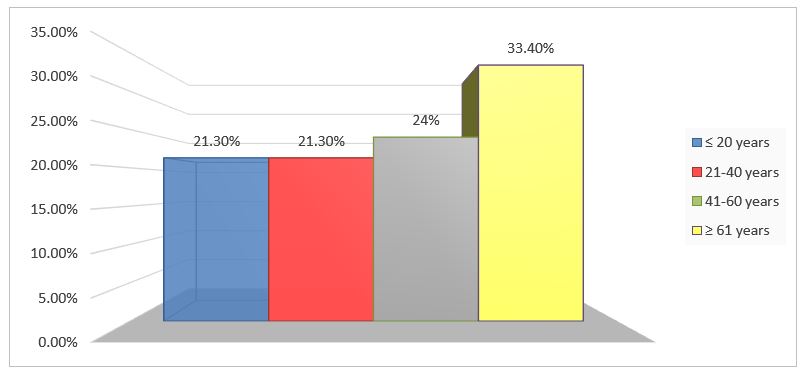
III-1-2 Sex
The sex ratiowas 0.34 in favor of women
Figure 2 shows the distribution of patients by sex

III-1-3 Origin of provenance
Figure 3 shows the distribution of patients according to their origin of origin
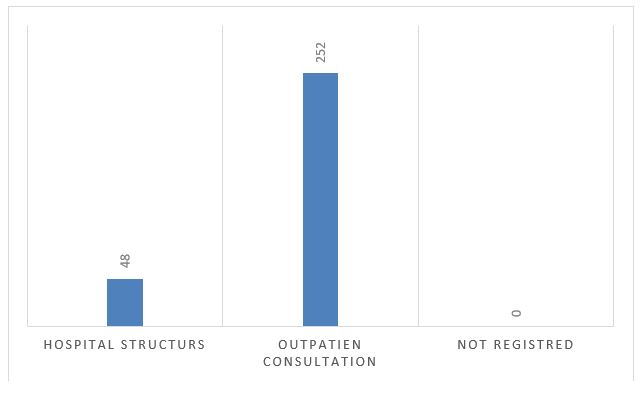
III-1-4 Patient hospitalization services
Figure 4 shows the distribution of patients according to reception services
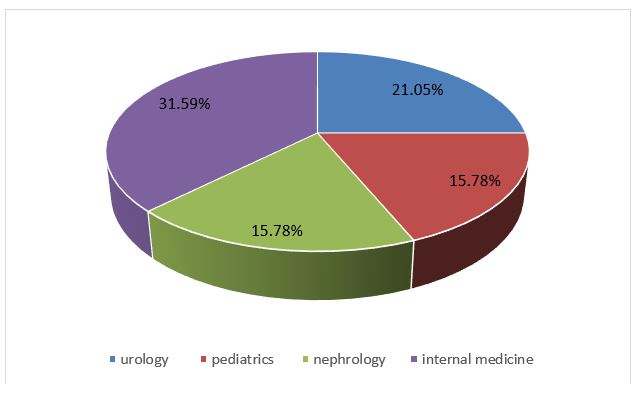
III-1-5 Types of samples
TableIshows the distribution of patients according to the type of sample

III-1-6 Facteurs des risques :

III-1-7 Breakdown of patients according to ECBU indication
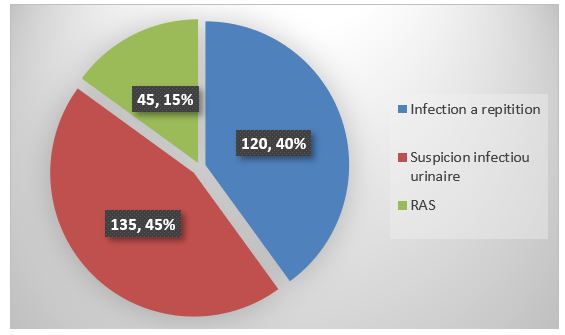
III-2 Bacteriological data
III-2-1 Overall distribution of enterobacteriaceae isolated according to bacterial species
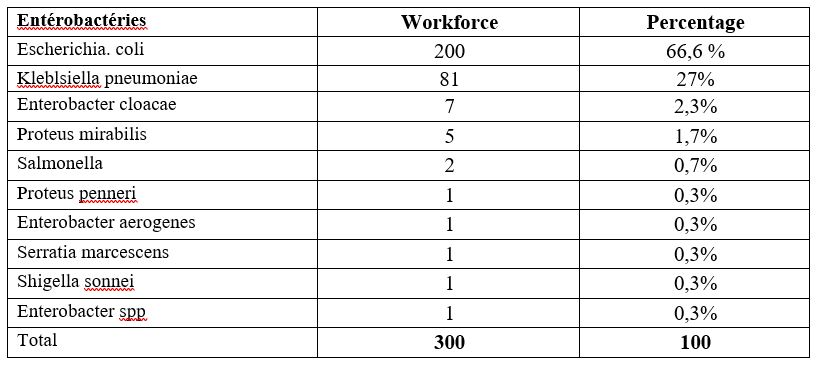
III-2-2 The distribution of bacterial species according to sex
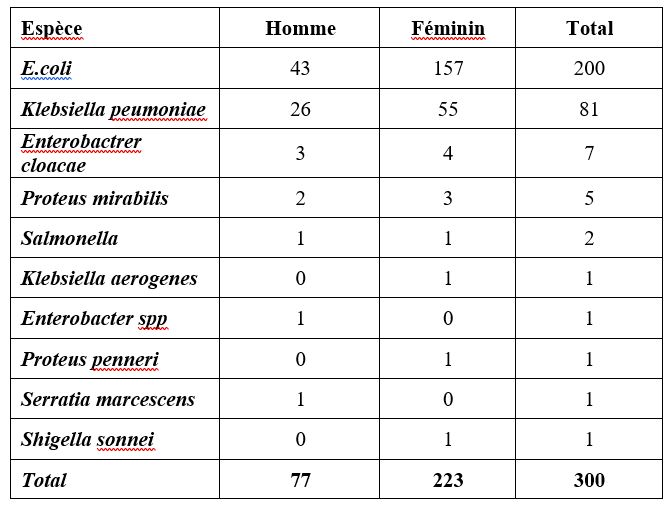
III-2-3 The distribution of bacterial species according to age

III-2-4 Beta-lactam resistance profile of E.coli
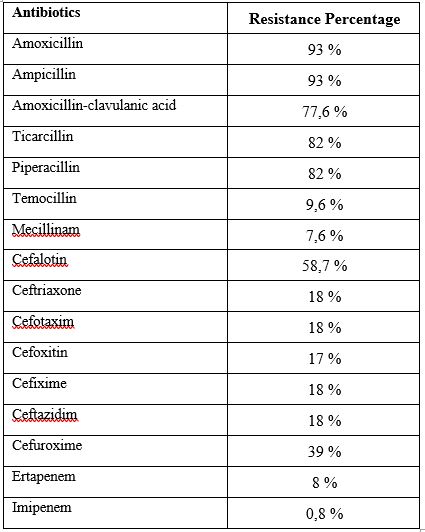
III-2-5 Resistance of E.coli to aminoglycosides
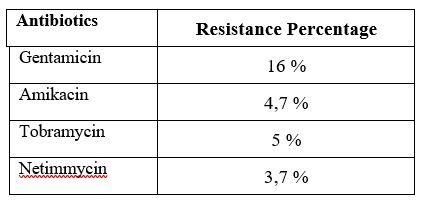
III-2-5 Resistance of E.coli to quinolones:

III-2-5 Resistance of E.Coli to other antibiotics:

III-2-6 Resistance of Klebsiella pneumoniae to beta-lactams:
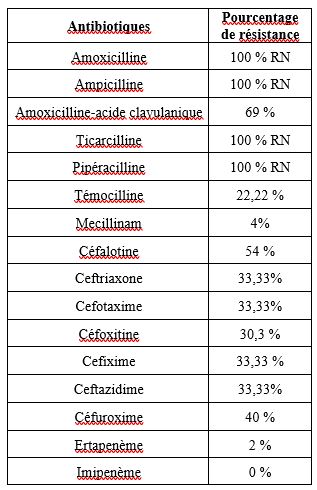
III-2-7 Resistance of Klebsiella pneumonia to aminoglycosides, quinolones and other antibiotics:
Tables XI, XII and XIII show the resistance of Klebsiella pneumonia to aminoglycosides, quinolones and other antibiotics.

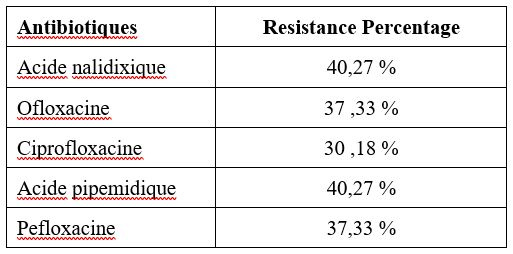
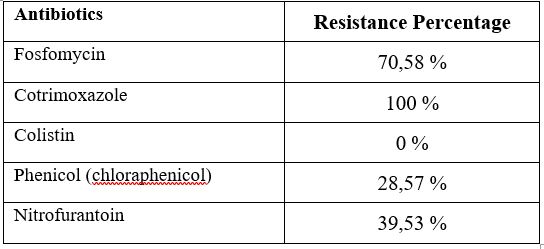
III-2-8 Resistorsof Enterobacter cloacae, Proteus mirabilis to beta-lactams and aminoglycosides:
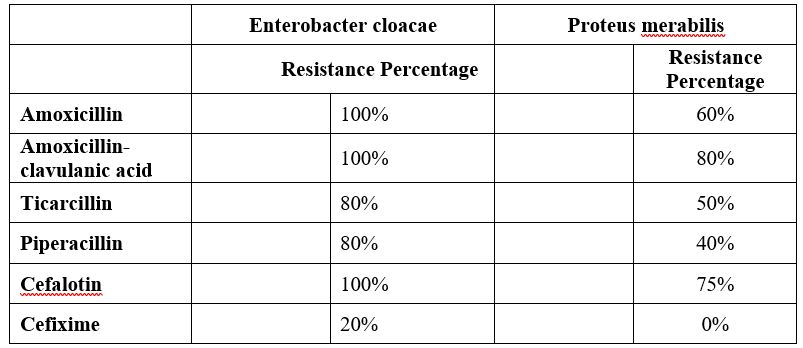

Resistance of other Enterobacteriaceae:
In our series we have 2 strains of salmonella which were resistant to amoxicillin, Ticarcillin, Piperacillin, no resistance to aminoglycosides or quinolones.
We have a single strain of Proteus penneri which was resistant, in addition to its natural resistance (to amoxicillin, C1G, cefuroxime) to Ticarcillin, amoxicillin+clavulanic acid, and to C2G while it was sensitive to C3G and all aminoglycosides and quinolones.
Our series contains a single strain of Klebsiella aerogenes that was resistant to C3G susceptible to aminoglycosides and quinolones.
For serratia marsescens we have a single strain which was resistant to the betalactamines tested (except carbapenems) while it was sensitive to aminoglycosides and quinolones.
IV-1 Epidemiological data:
IV-1-1 Age:
In our study the average age was 41.8 years with extremes of 1 and 83 years. The most affected age was over 61 with a percentage of 33.4%.
These results could be explained by the fact that these people are more vulnerable to infections because of the fragility of their immune system.
In a study carried out in the bacteriology-virology department of the National Institute of Public Health (INSP) in Bamako, a high frequency of positive ECBU was found in elderly patients (age > 60 years) with 30.4% of case or 183 samples. The average age of this study was 46 years (for the 567 samples whose age was entered) with the extremes ranging from 1 to 96 years[14].In 2017 a study by SABOR et al. showed that people over 60 were the most represented with a percentage of 25.37%.[15].In 2005 Zhanel et al in North America found a predominance of this same category in their studies with rates of 34.1%[16].
IV-1-2) Gender:
In our study, we found a female predominance giving a percentage of 74.3% with a sex ratio of 0.34. A study carried out by KALAMBRY in 2019 in Mali shows a female predominance with 54.2% of positive ECBU among women (326 out of 602 ECBU positives) and 43.0% in men (276 out of 602 ECBU positives) with a sex ratio of 1.18. This same observation has been made by other studies[17].Another study conducted in Morocco by Lahlou Amine also showed a female predominance with a female/male sex ratio of 1.08 (hospitalized: 0.52 and consultants: 1.48)[18] A studycarried out at the bacteriology-virology department of the National Institute of Public Health (INSP) in Bamako, a female predominance was noted with a sex ratio F/H=1.18[14].
This female predominance is linked to anatomical factors.
IV-1-3) Hospitalization structure:
In our study 94 patients from urology and 47 patients from the internal medicine department and 46 patients from the nephrology department.
In the study carried out at the bacteriology-virology department of the National Institute of Public Health (INSP) in Bamako on a sample of 602 cases, 37 patients from the urology department and 3 internal medicine patients and 4 patients from the nephrology[14].
At the CHNU de Fann in Dakar in 2015, which objectified a predominance of the neurology department, i.e. 42%, followed by the infectious and tropical diseases department with 35.68% of cases[19].
This could be explained by the long hospital stay and the use of invasive devices (urinary catheter, etc.), urological procedures and contributing factors such as prostate hypertrophy.
Breakdown by type of sample and place of origin:
The distribution of the species isolated according to the sampling sites reveals that ECBU are the most encountered, followed by suppuration from blood cultures and vaginal samples with rates of 97.33%, 2% and 0.33% and 0.33% respectively.
E. coli is by far the most frequently isolated germ, followed by Klebsiella pneumoniae. This is related to the pathophysiology of urinary tract infection which is generally ascending, and there is strong colonization of the perineum by enterobacteria of digestive origin, and in particular Escherichia coli. Added to this are specific uropathogenicity factors.
Thus, Escherichia coli has andesins, capable of binding the bacterium to the urinary epithelium and preventing its elimination through bladder emptying. Klebsiella secrete a urease which alkalizes the urine, whose naturally acidic pH prevents the proliferation of germs [20].
IV-2) Bacteriological data:
IV-2-1) Frequency of isolated species:
In our seriesEscherichia coliremains the most frequent species with an isolation rate of 66%, followed by Klebsiella pneumoniae 27.7%. This predominance is reported in several studies, but with frequencies varying between 46% and 60% for Escherichia coli, and between 9 and 28% for Klebsiella pneumoniae [2,21]. Enterobacter cloacae and Proteus mirabilis are less common with isolation rates of 2.3% and 1.7%. The same classification was reported by Nijssen et al but with lower rates of 2.2% and 2.9% respectively [22], while higher frequency rates were reported by Cherkaoui in 2014, 9% and 6% respectively [23]. The same observation is reported by Lagha in Algeria, but with rates of 4% and 9% respectively [2].
In the study carried out at the bacteriology-virology department of the National Institute of Public Health (INSP) in Bamako, Escherichia coli was the most isolated enterobacteriaceae (66.6%), probably because of its ability to adhere to cells, followed by Klebsiella pneumoniae (17.0%) [14], which is consistent witha studyrealizedat theHospitalof Mali in 2019[17]. In addition, SABOR in 2017 in DAKAR also found a predominance of these two species of enterobacteriaceae with a rate for Escherichia coli of 40.2% and 27.54% for Klebsiella pneumoniae [15].
Also, these species are distributed differently according to the sampling sites Escherichia coliis considered to be the leader of enterobacterial infections.
Escherichia coliis the most isolated bacterial species in women with 157 against 43 for men among the 200 species of Escherichia coli isolated in our study and affects subjects whose age is over 60 years. This female predominance is explainedpreviously on the basis of the fact that the risk of infections is 50 times more frequent in women, due to the proximity of the urinary meatus and the anus (short perineum) and the shortness of the urethra which is also wide and opens during sexual intercourse [6].
IV-2-2) Resistance to antibiotics:
During this study, we counted 10 different genera belonging to different families of the order Enterobacteraleswere tested against 29 molecules of antibiotics including 15b-lactams, 4 aminoglycosides, 5 quinolones, colistin, fosfomycin, chloraphenicol, Nitrofurantoin, and cothrimoxazole.
Enterobacteriaceae are classified into seven groups based on their natural resistance tob- lactams: Group 0 (Salmonella; Proteus mirabilis), Group1 (Escherichia coli; Shigellaspp), Group2 (Klebsiellaspp; Citrobacter diversus), Group 3 (Enterobacter spp; Serratia spp; Providencia spp; Citrobacter frendii; Hafnia alveii; Morganella), Group 4 (Yersinia), Group 5 (Proteus penneri; Proteus vulgaris), Group 6 (Kluyvera) [24].
Analysis of the resistance profile of Escherichia coli strains in our study shows an increase in resistance rates tob- lactams except carbapenems. Carbapenems and in particular imipenem are molecules of paramount importance which have sometimes become the only effective agents for the treatment of serious infections caused by enterobacteriaceae secreting ab- extended-spectrum lactams (ESBLE), the sensitivity of the latter to imipenem remains high according to several authors[25].
Low resistance rates were obtained for tobramycin 5%, gentamicin 16%, amikacin 4.7%, netilmicin 3.7%. Quinolone resistance has become a concern with a rate of 34.3% for nalidixic acid, 31.8% for ofloxacin, and 19.4% for ciprofloxacin.
While a high resistance rate was obtained for cotrimoxazole 68.42%.
In a study carried out in Bamako over 3 years, more than 72.6% of group I enterobacteriaceaeisolated showed resistance to the combination amoxicillin + clavulanic acid [14]. Our results are similar to those of KALAMBRY, 2019 in Mali, which found 71.0%[17].But they are lower than those of Kara Terki et al. In Algeria, which found 94.0% [26].
The multicenter study by Bouza et al.[27] reports a resistance rate of Escherichia coli of 55% vis-à-vis ampicillin.
A study carried out in the middleurology at the Henri-Mondor hospital, although old(unpublished data),shows that the rates ofresistance evolved from 1998 to 2005, going from 65 to 80% for amoxicillin, five to approximately 15% for cefotaxime, 20 to approximately 35% for ciprofloxacin, ten to more than 20% for gentamicin.
A study in Morocco by Lahlou A et al shows a very clear statistical relationship between the sensitivity to antibiotics that can be used orally for the treatment of cystitis and the history of antibiotic therapy is observed, especially when taking into account the type of antibiotic received: relationship between taking beta-lactams and resistance to amoxicillin - clavulanic acid, the difference in sensitivity being more than 20
Antibiotic resistance is one of the most serious threats to global health today. It is the cause of prolonged hospitalizations and leads to increased medical expenses and mortality. A better knowledge of the local bacterial ecology makes it possible to establish behaviors based on objective data
After the publication of its first report, in April 2014 on bacterial resistance, the WHO is alarmed by a “serious threat to public health” pointing to the ineffectiveness of antibiotics against certain bacteria.
This study, which falls within the framework of a survey on the state of bacterial resistance to antibiotics, has made it possible to highlight certain epidemiological characteristics.
During the study period, 300 strains of enterobacteriaceae were identified in the medical bacteriology laboratory of the CHN.
The rate of resistance to the usual antibiotics is high, this emergence of resistance would be linked to the importance of the prescription of an antibiotic
It is therefore important then
To implement a global management of the use of antibiotics with the aim of reducing and rationalizing their consumption, very early detection of infections with multidrug-resistant germs
Manage the risk factors for enterobacteriaceae infections.
Standard measures include hand washing with a hydroalcoholic solution, wearing gloves in the event of contact with biological fluid and wearing an overcoat in the event of contaminating care, regardless of the patient.
Our study is a prospective study which is related to all samples
Clearly Auctoresonline and particularly Psychology and Mental Health Care Journal is dedicated to improving health care services for individuals and populations. The editorial boards' ability to efficiently recognize and share the global importance of health literacy with a variety of stakeholders. Auctoresonline publishing platform can be used to facilitate of optimal client-based services and should be added to health care professionals' repertoire of evidence-based health care resources.

Journal of Clinical Cardiology and Cardiovascular Intervention The submission and review process was adequate. However I think that the publication total value should have been enlightened in early fases. Thank you for all.

Journal of Women Health Care and Issues By the present mail, I want to say thank to you and tour colleagues for facilitating my published article. Specially thank you for the peer review process, support from the editorial office. I appreciate positively the quality of your journal.
Journal of Clinical Research and Reports I would be very delighted to submit my testimonial regarding the reviewer board and the editorial office. The reviewer board were accurate and helpful regarding any modifications for my manuscript. And the editorial office were very helpful and supportive in contacting and monitoring with any update and offering help. It was my pleasure to contribute with your promising Journal and I am looking forward for more collaboration.

We would like to thank the Journal of Thoracic Disease and Cardiothoracic Surgery because of the services they provided us for our articles. The peer-review process was done in a very excellent time manner, and the opinions of the reviewers helped us to improve our manuscript further. The editorial office had an outstanding correspondence with us and guided us in many ways. During a hard time of the pandemic that is affecting every one of us tremendously, the editorial office helped us make everything easier for publishing scientific work. Hope for a more scientific relationship with your Journal.

The peer-review process which consisted high quality queries on the paper. I did answer six reviewers’ questions and comments before the paper was accepted. The support from the editorial office is excellent.

Journal of Neuroscience and Neurological Surgery. I had the experience of publishing a research article recently. The whole process was simple from submission to publication. The reviewers made specific and valuable recommendations and corrections that improved the quality of my publication. I strongly recommend this Journal.

Dr. Katarzyna Byczkowska My testimonial covering: "The peer review process is quick and effective. The support from the editorial office is very professional and friendly. Quality of the Clinical Cardiology and Cardiovascular Interventions is scientific and publishes ground-breaking research on cardiology that is useful for other professionals in the field.

Thank you most sincerely, with regard to the support you have given in relation to the reviewing process and the processing of my article entitled "Large Cell Neuroendocrine Carcinoma of The Prostate Gland: A Review and Update" for publication in your esteemed Journal, Journal of Cancer Research and Cellular Therapeutics". The editorial team has been very supportive.

Testimony of Journal of Clinical Otorhinolaryngology: work with your Reviews has been a educational and constructive experience. The editorial office were very helpful and supportive. It was a pleasure to contribute to your Journal.

Dr. Bernard Terkimbi Utoo, I am happy to publish my scientific work in Journal of Women Health Care and Issues (JWHCI). The manuscript submission was seamless and peer review process was top notch. I was amazed that 4 reviewers worked on the manuscript which made it a highly technical, standard and excellent quality paper. I appreciate the format and consideration for the APC as well as the speed of publication. It is my pleasure to continue with this scientific relationship with the esteem JWHCI.

This is an acknowledgment for peer reviewers, editorial board of Journal of Clinical Research and Reports. They show a lot of consideration for us as publishers for our research article “Evaluation of the different factors associated with side effects of COVID-19 vaccination on medical students, Mutah university, Al-Karak, Jordan”, in a very professional and easy way. This journal is one of outstanding medical journal.
Dear Hao Jiang, to Journal of Nutrition and Food Processing We greatly appreciate the efficient, professional and rapid processing of our paper by your team. If there is anything else we should do, please do not hesitate to let us know. On behalf of my co-authors, we would like to express our great appreciation to editor and reviewers.

As an author who has recently published in the journal "Brain and Neurological Disorders". I am delighted to provide a testimonial on the peer review process, editorial office support, and the overall quality of the journal. The peer review process at Brain and Neurological Disorders is rigorous and meticulous, ensuring that only high-quality, evidence-based research is published. The reviewers are experts in their fields, and their comments and suggestions were constructive and helped improve the quality of my manuscript. The review process was timely and efficient, with clear communication from the editorial office at each stage. The support from the editorial office was exceptional throughout the entire process. The editorial staff was responsive, professional, and always willing to help. They provided valuable guidance on formatting, structure, and ethical considerations, making the submission process seamless. Moreover, they kept me informed about the status of my manuscript and provided timely updates, which made the process less stressful. The journal Brain and Neurological Disorders is of the highest quality, with a strong focus on publishing cutting-edge research in the field of neurology. The articles published in this journal are well-researched, rigorously peer-reviewed, and written by experts in the field. The journal maintains high standards, ensuring that readers are provided with the most up-to-date and reliable information on brain and neurological disorders. In conclusion, I had a wonderful experience publishing in Brain and Neurological Disorders. The peer review process was thorough, the editorial office provided exceptional support, and the journal's quality is second to none. I would highly recommend this journal to any researcher working in the field of neurology and brain disorders.

Dear Agrippa Hilda, Journal of Neuroscience and Neurological Surgery, Editorial Coordinator, I trust this message finds you well. I want to extend my appreciation for considering my article for publication in your esteemed journal. I am pleased to provide a testimonial regarding the peer review process and the support received from your editorial office. The peer review process for my paper was carried out in a highly professional and thorough manner. The feedback and comments provided by the authors were constructive and very useful in improving the quality of the manuscript. This rigorous assessment process undoubtedly contributes to the high standards maintained by your journal.

International Journal of Clinical Case Reports and Reviews. I strongly recommend to consider submitting your work to this high-quality journal. The support and availability of the Editorial staff is outstanding and the review process was both efficient and rigorous.

Thank you very much for publishing my Research Article titled “Comparing Treatment Outcome Of Allergic Rhinitis Patients After Using Fluticasone Nasal Spray And Nasal Douching" in the Journal of Clinical Otorhinolaryngology. As Medical Professionals we are immensely benefited from study of various informative Articles and Papers published in this high quality Journal. I look forward to enriching my knowledge by regular study of the Journal and contribute my future work in the field of ENT through the Journal for use by the medical fraternity. The support from the Editorial office was excellent and very prompt. I also welcome the comments received from the readers of my Research Article.

Dear Erica Kelsey, Editorial Coordinator of Cancer Research and Cellular Therapeutics Our team is very satisfied with the processing of our paper by your journal. That was fast, efficient, rigorous, but without unnecessary complications. We appreciated the very short time between the submission of the paper and its publication on line on your site.

I am very glad to say that the peer review process is very successful and fast and support from the Editorial Office. Therefore, I would like to continue our scientific relationship for a long time. And I especially thank you for your kindly attention towards my article. Have a good day!

"We recently published an article entitled “Influence of beta-Cyclodextrins upon the Degradation of Carbofuran Derivatives under Alkaline Conditions" in the Journal of “Pesticides and Biofertilizers” to show that the cyclodextrins protect the carbamates increasing their half-life time in the presence of basic conditions This will be very helpful to understand carbofuran behaviour in the analytical, agro-environmental and food areas. We greatly appreciated the interaction with the editor and the editorial team; we were particularly well accompanied during the course of the revision process, since all various steps towards publication were short and without delay".

I would like to express my gratitude towards you process of article review and submission. I found this to be very fair and expedient. Your follow up has been excellent. I have many publications in national and international journal and your process has been one of the best so far. Keep up the great work.

We are grateful for this opportunity to provide a glowing recommendation to the Journal of Psychiatry and Psychotherapy. We found that the editorial team were very supportive, helpful, kept us abreast of timelines and over all very professional in nature. The peer review process was rigorous, efficient and constructive that really enhanced our article submission. The experience with this journal remains one of our best ever and we look forward to providing future submissions in the near future.

I am very pleased to serve as EBM of the journal, I hope many years of my experience in stem cells can help the journal from one way or another. As we know, stem cells hold great potential for regenerative medicine, which are mostly used to promote the repair response of diseased, dysfunctional or injured tissue using stem cells or their derivatives. I think Stem Cell Research and Therapeutics International is a great platform to publish and share the understanding towards the biology and translational or clinical application of stem cells.

I would like to give my testimony in the support I have got by the peer review process and to support the editorial office where they were of asset to support young author like me to be encouraged to publish their work in your respected journal and globalize and share knowledge across the globe. I really give my great gratitude to your journal and the peer review including the editorial office.

I am delighted to publish our manuscript entitled "A Perspective on Cocaine Induced Stroke - Its Mechanisms and Management" in the Journal of Neuroscience and Neurological Surgery. The peer review process, support from the editorial office, and quality of the journal are excellent. The manuscripts published are of high quality and of excellent scientific value. I recommend this journal very much to colleagues.

Dr.Tania Muñoz, My experience as researcher and author of a review article in The Journal Clinical Cardiology and Interventions has been very enriching and stimulating. The editorial team is excellent, performs its work with absolute responsibility and delivery. They are proactive, dynamic and receptive to all proposals. Supporting at all times the vast universe of authors who choose them as an option for publication. The team of review specialists, members of the editorial board, are brilliant professionals, with remarkable performance in medical research and scientific methodology. Together they form a frontline team that consolidates the JCCI as a magnificent option for the publication and review of high-level medical articles and broad collective interest. I am honored to be able to share my review article and open to receive all your comments.

“The peer review process of JPMHC is quick and effective. Authors are benefited by good and professional reviewers with huge experience in the field of psychology and mental health. The support from the editorial office is very professional. People to contact to are friendly and happy to help and assist any query authors might have. Quality of the Journal is scientific and publishes ground-breaking research on mental health that is useful for other professionals in the field”.

Dear editorial department: On behalf of our team, I hereby certify the reliability and superiority of the International Journal of Clinical Case Reports and Reviews in the peer review process, editorial support, and journal quality. Firstly, the peer review process of the International Journal of Clinical Case Reports and Reviews is rigorous, fair, transparent, fast, and of high quality. The editorial department invites experts from relevant fields as anonymous reviewers to review all submitted manuscripts. These experts have rich academic backgrounds and experience, and can accurately evaluate the academic quality, originality, and suitability of manuscripts. The editorial department is committed to ensuring the rigor of the peer review process, while also making every effort to ensure a fast review cycle to meet the needs of authors and the academic community. Secondly, the editorial team of the International Journal of Clinical Case Reports and Reviews is composed of a group of senior scholars and professionals with rich experience and professional knowledge in related fields. The editorial department is committed to assisting authors in improving their manuscripts, ensuring their academic accuracy, clarity, and completeness. Editors actively collaborate with authors, providing useful suggestions and feedback to promote the improvement and development of the manuscript. We believe that the support of the editorial department is one of the key factors in ensuring the quality of the journal. Finally, the International Journal of Clinical Case Reports and Reviews is renowned for its high- quality articles and strict academic standards. The editorial department is committed to publishing innovative and academically valuable research results to promote the development and progress of related fields. The International Journal of Clinical Case Reports and Reviews is reasonably priced and ensures excellent service and quality ratio, allowing authors to obtain high-level academic publishing opportunities in an affordable manner. I hereby solemnly declare that the International Journal of Clinical Case Reports and Reviews has a high level of credibility and superiority in terms of peer review process, editorial support, reasonable fees, and journal quality. Sincerely, Rui Tao.

Clinical Cardiology and Cardiovascular Interventions I testity the covering of the peer review process, support from the editorial office, and quality of the journal.

Clinical Cardiology and Cardiovascular Interventions, we deeply appreciate the interest shown in our work and its publication. It has been a true pleasure to collaborate with you. The peer review process, as well as the support provided by the editorial office, have been exceptional, and the quality of the journal is very high, which was a determining factor in our decision to publish with you.
The peer reviewers process is quick and effective, the supports from editorial office is excellent, the quality of journal is high. I would like to collabroate with Internatioanl journal of Clinical Case Reports and Reviews journal clinically in the future time.

Clinical Cardiology and Cardiovascular Interventions, I would like to express my sincerest gratitude for the trust placed in our team for the publication in your journal. It has been a true pleasure to collaborate with you on this project. I am pleased to inform you that both the peer review process and the attention from the editorial coordination have been excellent. Your team has worked with dedication and professionalism to ensure that your publication meets the highest standards of quality. We are confident that this collaboration will result in mutual success, and we are eager to see the fruits of this shared effort.

Dear Dr. Jessica Magne, Editorial Coordinator 0f Clinical Cardiology and Cardiovascular Interventions, I hope this message finds you well. I want to express my utmost gratitude for your excellent work and for the dedication and speed in the publication process of my article titled "Navigating Innovation: Qualitative Insights on Using Technology for Health Education in Acute Coronary Syndrome Patients." I am very satisfied with the peer review process, the support from the editorial office, and the quality of the journal. I hope we can maintain our scientific relationship in the long term.
Dear Monica Gissare, - Editorial Coordinator of Nutrition and Food Processing. ¨My testimony with you is truly professional, with a positive response regarding the follow-up of the article and its review, you took into account my qualities and the importance of the topic¨.

Dear Dr. Jessica Magne, Editorial Coordinator 0f Clinical Cardiology and Cardiovascular Interventions, The review process for the article “The Handling of Anti-aggregants and Anticoagulants in the Oncologic Heart Patient Submitted to Surgery” was extremely rigorous and detailed. From the initial submission to the final acceptance, the editorial team at the “Journal of Clinical Cardiology and Cardiovascular Interventions” demonstrated a high level of professionalism and dedication. The reviewers provided constructive and detailed feedback, which was essential for improving the quality of our work. Communication was always clear and efficient, ensuring that all our questions were promptly addressed. The quality of the “Journal of Clinical Cardiology and Cardiovascular Interventions” is undeniable. It is a peer-reviewed, open-access publication dedicated exclusively to disseminating high-quality research in the field of clinical cardiology and cardiovascular interventions. The journal's impact factor is currently under evaluation, and it is indexed in reputable databases, which further reinforces its credibility and relevance in the scientific field. I highly recommend this journal to researchers looking for a reputable platform to publish their studies.

Dear Editorial Coordinator of the Journal of Nutrition and Food Processing! "I would like to thank the Journal of Nutrition and Food Processing for including and publishing my article. The peer review process was very quick, movement and precise. The Editorial Board has done an extremely conscientious job with much help, valuable comments and advices. I find the journal very valuable from a professional point of view, thank you very much for allowing me to be part of it and I would like to participate in the future!”

Dealing with The Journal of Neurology and Neurological Surgery was very smooth and comprehensive. The office staff took time to address my needs and the response from editors and the office was prompt and fair. I certainly hope to publish with this journal again.Their professionalism is apparent and more than satisfactory. Susan Weiner

My Testimonial Covering as fellowing: Lin-Show Chin. The peer reviewers process is quick and effective, the supports from editorial office is excellent, the quality of journal is high. I would like to collabroate with Internatioanl journal of Clinical Case Reports and Reviews.

My experience publishing in Psychology and Mental Health Care was exceptional. The peer review process was rigorous and constructive, with reviewers providing valuable insights that helped enhance the quality of our work. The editorial team was highly supportive and responsive, making the submission process smooth and efficient. The journal's commitment to high standards and academic rigor makes it a respected platform for quality research. I am grateful for the opportunity to publish in such a reputable journal.
My experience publishing in International Journal of Clinical Case Reports and Reviews was exceptional. I Come forth to Provide a Testimonial Covering the Peer Review Process and the editorial office for the Professional and Impartial Evaluation of the Manuscript.

I would like to offer my testimony in the support. I have received through the peer review process and support the editorial office where they are to support young authors like me, encourage them to publish their work in your esteemed journals, and globalize and share knowledge globally. I really appreciate your journal, peer review, and editorial office.
Dear Agrippa Hilda- Editorial Coordinator of Journal of Neuroscience and Neurological Surgery, "The peer review process was very quick and of high quality, which can also be seen in the articles in the journal. The collaboration with the editorial office was very good."

I would like to express my sincere gratitude for the support and efficiency provided by the editorial office throughout the publication process of my article, “Delayed Vulvar Metastases from Rectal Carcinoma: A Case Report.” I greatly appreciate the assistance and guidance I received from your team, which made the entire process smooth and efficient. The peer review process was thorough and constructive, contributing to the overall quality of the final article. I am very grateful for the high level of professionalism and commitment shown by the editorial staff, and I look forward to maintaining a long-term collaboration with the International Journal of Clinical Case Reports and Reviews.
To Dear Erin Aust, I would like to express my heartfelt appreciation for the opportunity to have my work published in this esteemed journal. The entire publication process was smooth and well-organized, and I am extremely satisfied with the final result. The Editorial Team demonstrated the utmost professionalism, providing prompt and insightful feedback throughout the review process. Their clear communication and constructive suggestions were invaluable in enhancing my manuscript, and their meticulous attention to detail and dedication to quality are truly commendable. Additionally, the support from the Editorial Office was exceptional. From the initial submission to the final publication, I was guided through every step of the process with great care and professionalism. The team's responsiveness and assistance made the entire experience both easy and stress-free. I am also deeply impressed by the quality and reputation of the journal. It is an honor to have my research featured in such a respected publication, and I am confident that it will make a meaningful contribution to the field.

"I am grateful for the opportunity of contributing to [International Journal of Clinical Case Reports and Reviews] and for the rigorous review process that enhances the quality of research published in your esteemed journal. I sincerely appreciate the time and effort of your team who have dedicatedly helped me in improvising changes and modifying my manuscript. The insightful comments and constructive feedback provided have been invaluable in refining and strengthening my work".

I thank the ‘Journal of Clinical Research and Reports’ for accepting this article for publication. This is a rigorously peer reviewed journal which is on all major global scientific data bases. I note the review process was prompt, thorough and professionally critical. It gave us an insight into a number of important scientific/statistical issues. The review prompted us to review the relevant literature again and look at the limitations of the study. The peer reviewers were open, clear in the instructions and the editorial team was very prompt in their communication. This journal certainly publishes quality research articles. I would recommend the journal for any future publications.

Dear Jessica Magne, with gratitude for the joint work. Fast process of receiving and processing the submitted scientific materials in “Clinical Cardiology and Cardiovascular Interventions”. High level of competence of the editors with clear and correct recommendations and ideas for enriching the article.

We found the peer review process quick and positive in its input. The support from the editorial officer has been very agile, always with the intention of improving the article and taking into account our subsequent corrections.

My article, titled 'No Way Out of the Smartphone Epidemic Without Considering the Insights of Brain Research,' has been republished in the International Journal of Clinical Case Reports and Reviews. The review process was seamless and professional, with the editors being both friendly and supportive. I am deeply grateful for their efforts.
To Dear Erin Aust – Editorial Coordinator of Journal of General Medicine and Clinical Practice! I declare that I am absolutely satisfied with your work carried out with great competence in following the manuscript during the various stages from its receipt, during the revision process to the final acceptance for publication. Thank Prof. Elvira Farina

Dear Jessica, and the super professional team of the ‘Clinical Cardiology and Cardiovascular Interventions’ I am sincerely grateful to the coordinated work of the journal team for the no problem with the submission of my manuscript: “Cardiometabolic Disorders in A Pregnant Woman with Severe Preeclampsia on the Background of Morbid Obesity (Case Report).” The review process by 5 experts was fast, and the comments were professional, which made it more specific and academic, and the process of publication and presentation of the article was excellent. I recommend that my colleagues publish articles in this journal, and I am interested in further scientific cooperation. Sincerely and best wishes, Dr. Oleg Golyanovskiy.

Dear Ashley Rosa, Editorial Coordinator of the journal - Psychology and Mental Health Care. " The process of obtaining publication of my article in the Psychology and Mental Health Journal was positive in all areas. The peer review process resulted in a number of valuable comments, the editorial process was collaborative and timely, and the quality of this journal has been quickly noticed, resulting in alternative journals contacting me to publish with them." Warm regards, Susan Anne Smith, PhD. Australian Breastfeeding Association.

Dear Jessica Magne, Editorial Coordinator, Clinical Cardiology and Cardiovascular Interventions, Auctores Publishing LLC. I appreciate the journal (JCCI) editorial office support, the entire team leads were always ready to help, not only on technical front but also on thorough process. Also, I should thank dear reviewers’ attention to detail and creative approach to teach me and bring new insights by their comments. Surely, more discussions and introduction of other hemodynamic devices would provide better prevention and management of shock states. Your efforts and dedication in presenting educational materials in this journal are commendable. Best wishes from, Farahnaz Fallahian.
Dear Maria Emerson, Editorial Coordinator, International Journal of Clinical Case Reports and Reviews, Auctores Publishing LLC. I am delighted to have published our manuscript, "Acute Colonic Pseudo-Obstruction (ACPO): A rare but serious complication following caesarean section." I want to thank the editorial team, especially Maria Emerson, for their prompt review of the manuscript, quick responses to queries, and overall support. Yours sincerely Dr. Victor Olagundoye.

Dear Ashley Rosa, Editorial Coordinator, International Journal of Clinical Case Reports and Reviews. Many thanks for publishing this manuscript after I lost confidence the editors were most helpful, more than other journals Best wishes from, Susan Anne Smith, PhD. Australian Breastfeeding Association.

Dear Agrippa Hilda, Editorial Coordinator, Journal of Neuroscience and Neurological Surgery. The entire process including article submission, review, revision, and publication was extremely easy. The journal editor was prompt and helpful, and the reviewers contributed to the quality of the paper. Thank you so much! Eric Nussbaum, MD
Dr Hala Al Shaikh This is to acknowledge that the peer review process for the article ’ A Novel Gnrh1 Gene Mutation in Four Omani Male Siblings, Presentation and Management ’ sent to the International Journal of Clinical Case Reports and Reviews was quick and smooth. The editorial office was prompt with easy communication.

Dear Erin Aust, Editorial Coordinator, Journal of General Medicine and Clinical Practice. We are pleased to share our experience with the “Journal of General Medicine and Clinical Practice”, following the successful publication of our article. The peer review process was thorough and constructive, helping to improve the clarity and quality of the manuscript. We are especially thankful to Ms. Erin Aust, the Editorial Coordinator, for her prompt communication and continuous support throughout the process. Her professionalism ensured a smooth and efficient publication experience. The journal upholds high editorial standards, and we highly recommend it to fellow researchers seeking a credible platform for their work. Best wishes By, Dr. Rakhi Mishra.

Dear Jessica Magne, Editorial Coordinator, Clinical Cardiology and Cardiovascular Interventions, Auctores Publishing LLC. The peer review process of the journal of Clinical Cardiology and Cardiovascular Interventions was excellent and fast, as was the support of the editorial office and the quality of the journal. Kind regards Walter F. Riesen Prof. Dr. Dr. h.c. Walter F. Riesen.

Dear Ashley Rosa, Editorial Coordinator, International Journal of Clinical Case Reports and Reviews, Auctores Publishing LLC. Thank you for publishing our article, Exploring Clozapine's Efficacy in Managing Aggression: A Multiple Single-Case Study in Forensic Psychiatry in the international journal of clinical case reports and reviews. We found the peer review process very professional and efficient. The comments were constructive, and the whole process was efficient. On behalf of the co-authors, I would like to thank you for publishing this article. With regards, Dr. Jelle R. Lettinga.

Dear Clarissa Eric, Editorial Coordinator, Journal of Clinical Case Reports and Studies, I would like to express my deep admiration for the exceptional professionalism demonstrated by your journal. I am thoroughly impressed by the speed of the editorial process, the substantive and insightful reviews, and the meticulous preparation of the manuscript for publication. Additionally, I greatly appreciate the courteous and immediate responses from your editorial office to all my inquiries. Best Regards, Dariusz Ziora

Dear Chrystine Mejia, Editorial Coordinator, Journal of Neurodegeneration and Neurorehabilitation, Auctores Publishing LLC, We would like to thank the editorial team for the smooth and high-quality communication leading up to the publication of our article in the Journal of Neurodegeneration and Neurorehabilitation. The reviewers have extensive knowledge in the field, and their relevant questions helped to add value to our publication. Kind regards, Dr. Ravi Shrivastava.

Dear Clarissa Eric, Editorial Coordinator, Journal of Clinical Case Reports and Studies, Auctores Publishing LLC, USA Office: +1-(302)-520-2644. I would like to express my sincere appreciation for the efficient and professional handling of my case report by the ‘Journal of Clinical Case Reports and Studies’. The peer review process was not only fast but also highly constructive—the reviewers’ comments were clear, relevant, and greatly helped me improve the quality and clarity of my manuscript. I also received excellent support from the editorial office throughout the process. Communication was smooth and timely, and I felt well guided at every stage, from submission to publication. The overall quality and rigor of the journal are truly commendable. I am pleased to have published my work with Journal of Clinical Case Reports and Studies, and I look forward to future opportunities for collaboration. Sincerely, Aline Tollet, UCLouvain.

Dear Ms. Mayra Duenas, Editorial Coordinator, International Journal of Clinical Case Reports and Reviews. “The International Journal of Clinical Case Reports and Reviews represented the “ideal house” to share with the research community a first experience with the use of the Simeox device for speech rehabilitation. High scientific reputation and attractive website communication were first determinants for the selection of this Journal, and the following submission process exceeded expectations: fast but highly professional peer review, great support by the editorial office, elegant graphic layout. Exactly what a dynamic research team - also composed by allied professionals - needs!" From, Chiara Beccaluva, PT - Italy.

Dear Maria Emerson, Editorial Coordinator, we have deeply appreciated the professionalism demonstrated by the International Journal of Clinical Case Reports and Reviews. The reviewers have extensive knowledge of our field and have been very efficient and fast in supporting the process. I am really looking forward to further collaboration. Thanks. Best regards, Dr. Claudio Ligresti